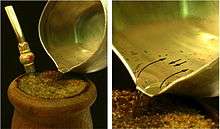Upstream contamination

Upstream contamination by floating particles is a counterintuitive phenomenon in fluid dynamics. When pouring water from a higher container to a lower one, particles floating in the latter can climb upstream into the upper container. A definitive explanation is still lacking: experimental and computational evidence indicates that the contamination is chiefly driven by surface tension gradients, however the phenomenon is also affected by the dynamics of swirling flows that remain to be fully investigated.
Origins

The phenomenon was first observed in 2008 by the Argentinian S. Bianchini during mate tea preparation, while studying Physics at the University of Havana.
It rapidly attracted the interest of Prof. A. Lage, who performed, with Bianchini, a series of controlled experiments. Later on Prof. E. Altshuler completed the trio in Havana, which resulted in the Diploma thesis of Bianchini and a short original paper posted in the web arxiv[1] and commented as a surprising fact in some online journals.[2][3] [4] [5]
Bianchini's Diploma thesis showed that the phenomenon could be reproduced in a controlled laboratory setting using mate leaves or chalk powder as contaminants, and that temperature gradients (hot in the top, cold in the bottom) were not necessary to generate the effect. The research also showed that surface tension was a key element to the explanation through the so-called Marangoni effect, which was suggested by two facts: (a) both mate and chalk lowered the surface tension of water, and (b) if an industrial surfactant was added on the upper reservoir, the upstream motion of particles would stop.
Confirmation
After a talk by A. Lage at the First Workshop on Complex Matter Physics in Havana (MarchCOMeeting'2012), Prof. T Shinbrot (Rutgers University) got interested in the subject. Together with student T. Siu, Cuban results were confirmed and expanded with new experiments and numerical simulations at Rutgers, which resulted in a joint peer-reviewed paper.[6]
Later on, the phenomenon has been confirmed independently by others.[7] Whether it is caused solely by surface tension gradients or depends also on dynamical behaviors of the falling water still remains as an open question.
Videos of the effect are available on YouTube.[8][9]
Implications
The phenomenon of upstream contamination could be relevant to industrial and biotechnological processes, and may be connected even to movements of the protoplasm. It could imply that some of the good practices in industrial and biotechnological procedures need revision.
References
- ↑ Bianchini S.; et al. (2011). "Upstream contamination in water pouring". arXiv:1105.2585
 .
. - ↑ "Contaminants Can Flow Up Waterfalls, Say Physicists". 2011.
- ↑ "Small Particles Can Flow Up Waterfalls, Say Tea-Drinking Physicists". 2011.
- ↑ "Some particles are able to flow up small waterfalls, physicists show". 2011.
- ↑ "Particles defy gravity, float upstream". 2013.
- ↑ Bianchini S.; et al. (2013). "Upstream contamination by floating particles". Proceedings of the Royal Society A. 469: 20130067. Bibcode:2013RSPSA.46930067B. doi:10.1098/rspa.2013.0067.
- ↑ "Upstream Contamination by Floating Particles". 2014.
- ↑ A. Lage-Castellanos (2013). "Upstream contamination in water pouring".
- ↑ "Upstream Contamination by Floating Particles". 2014.